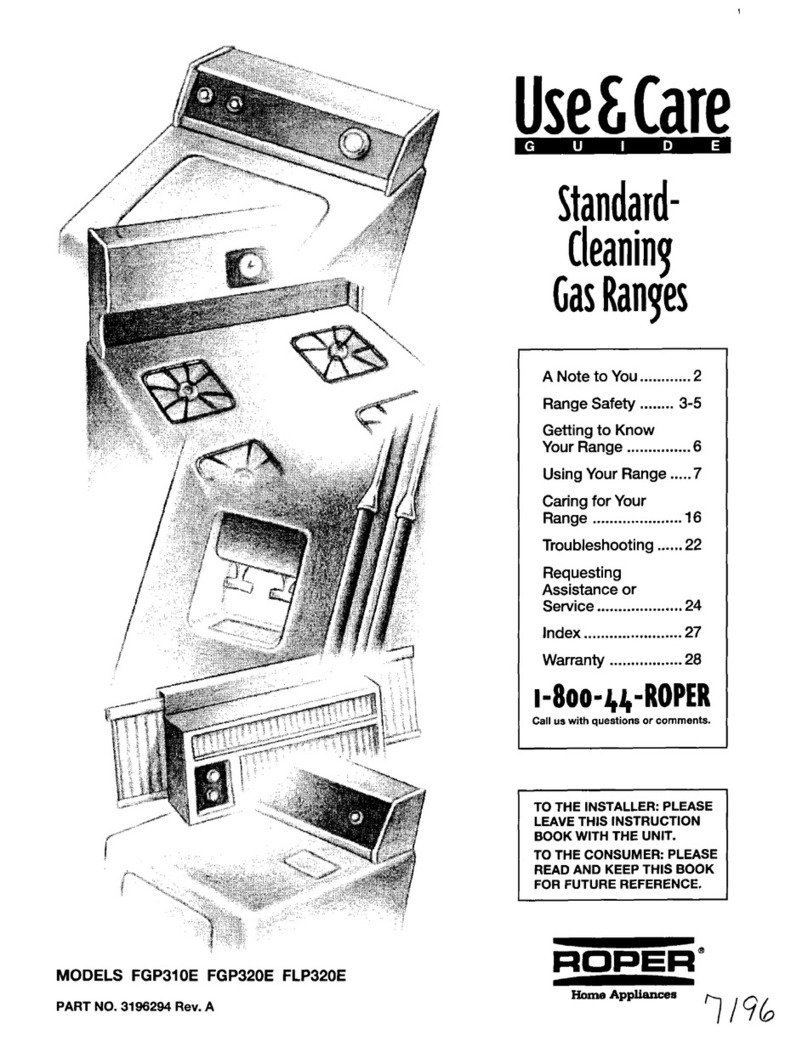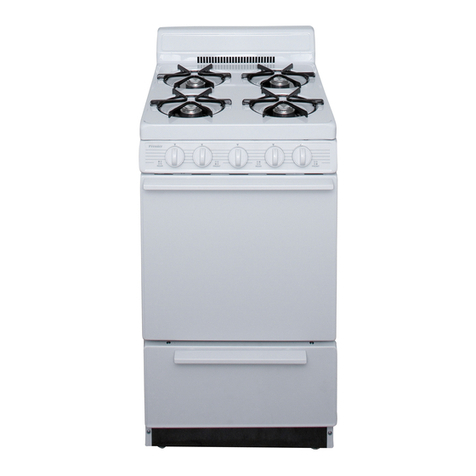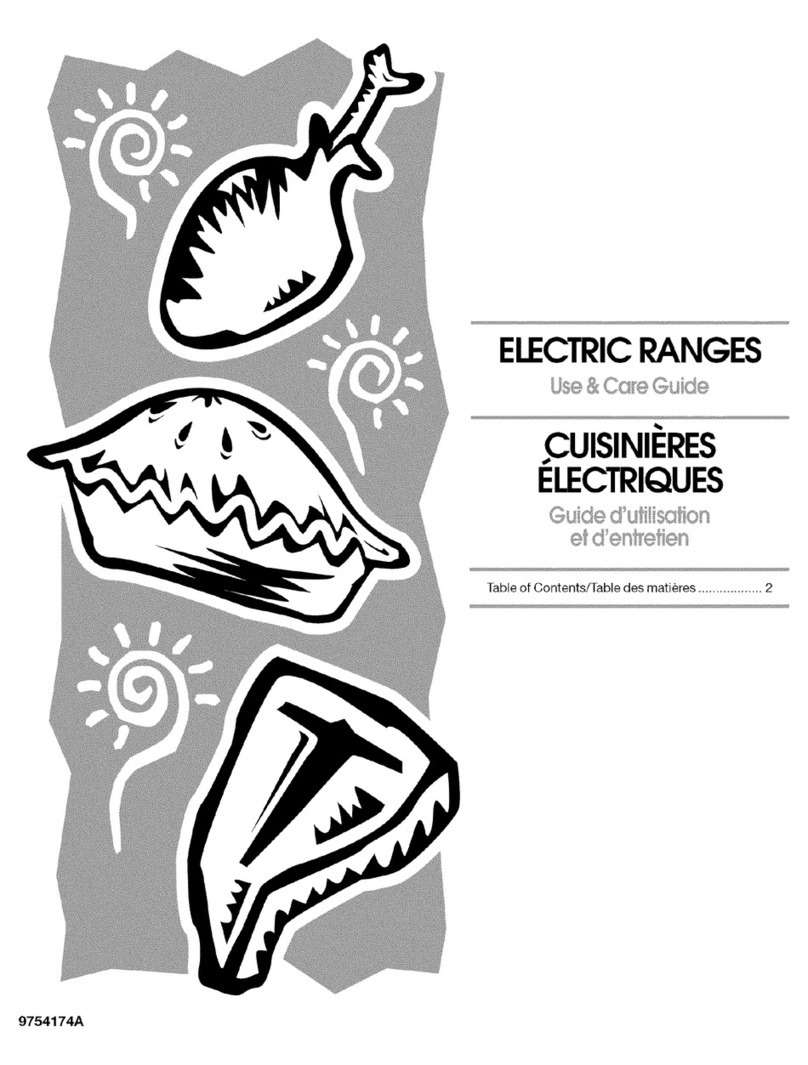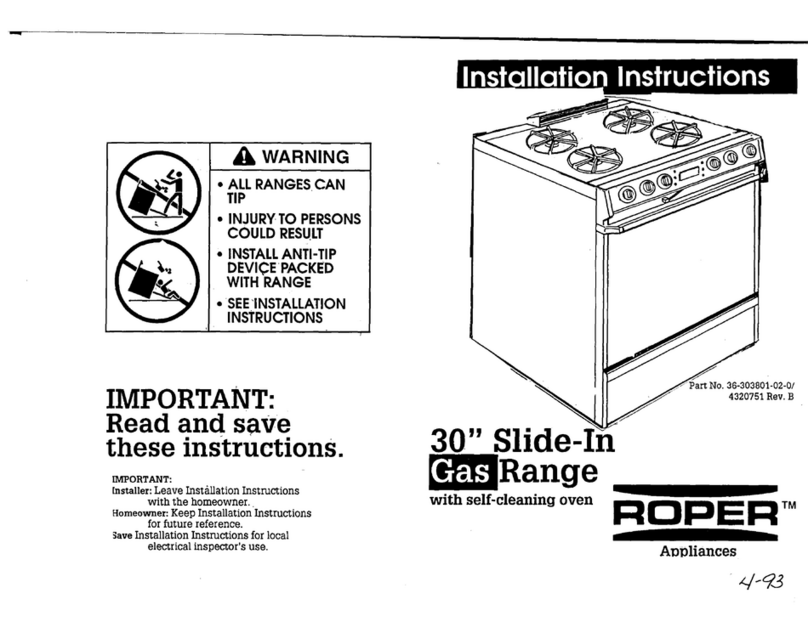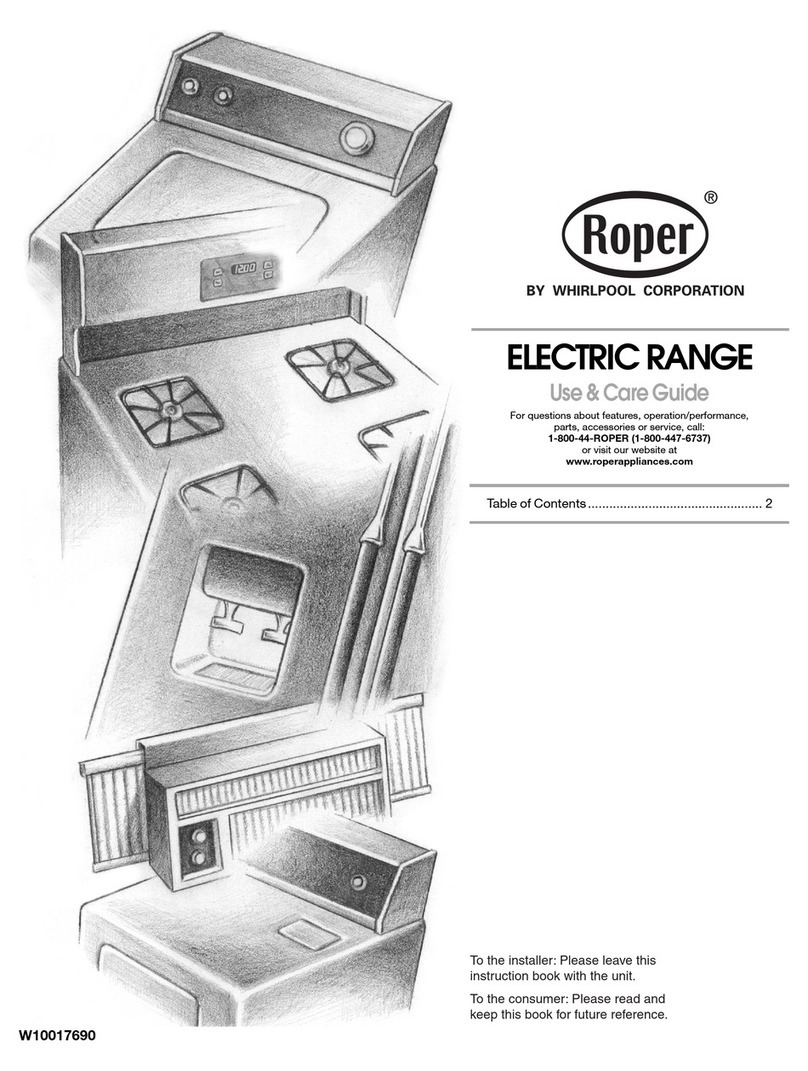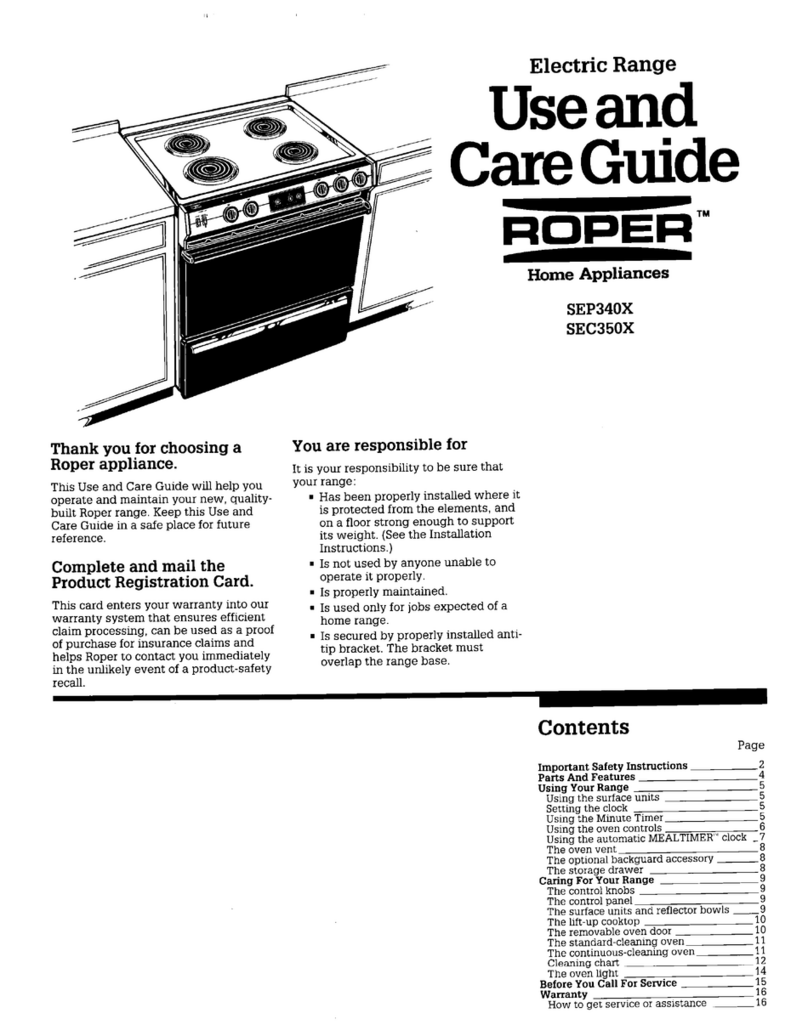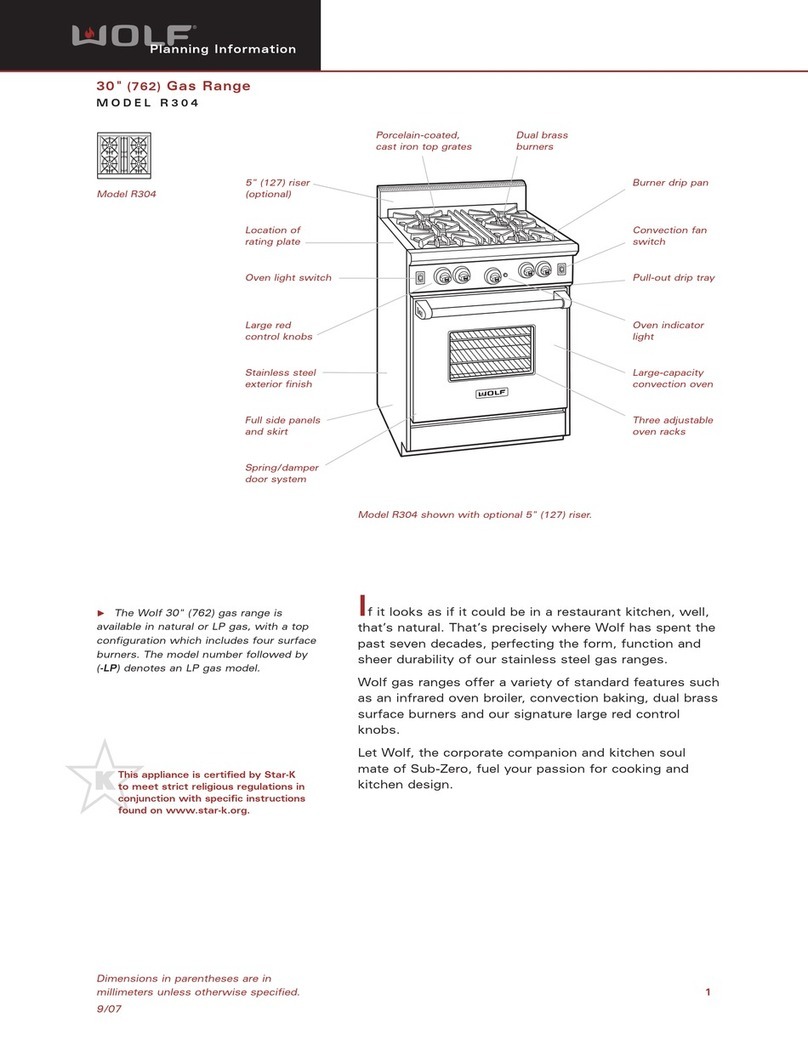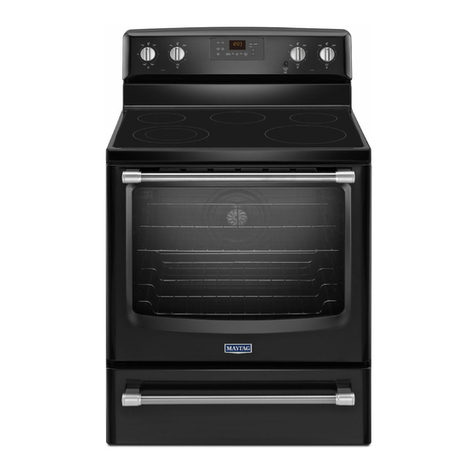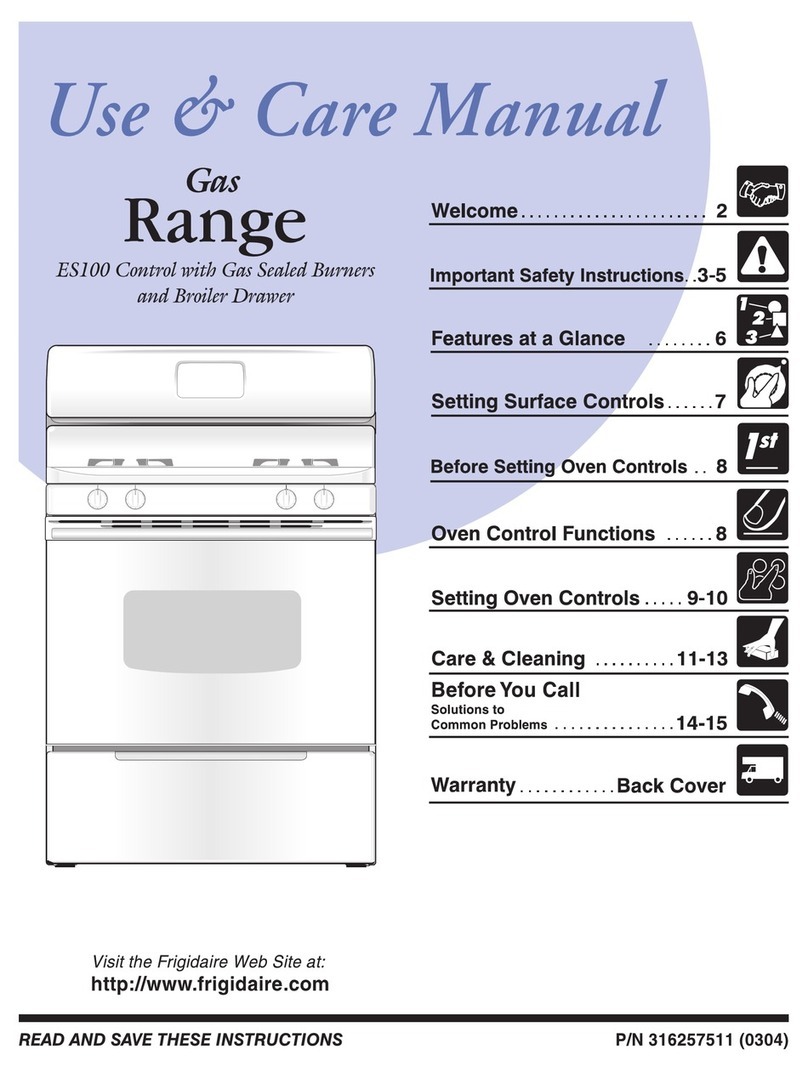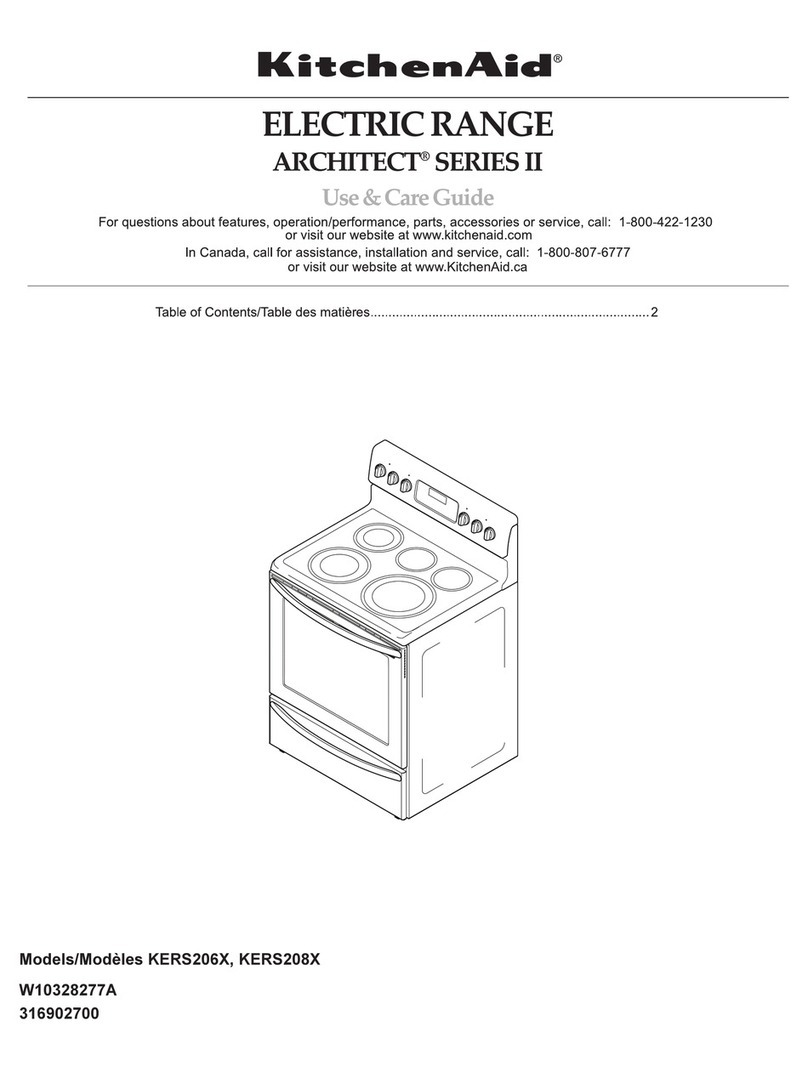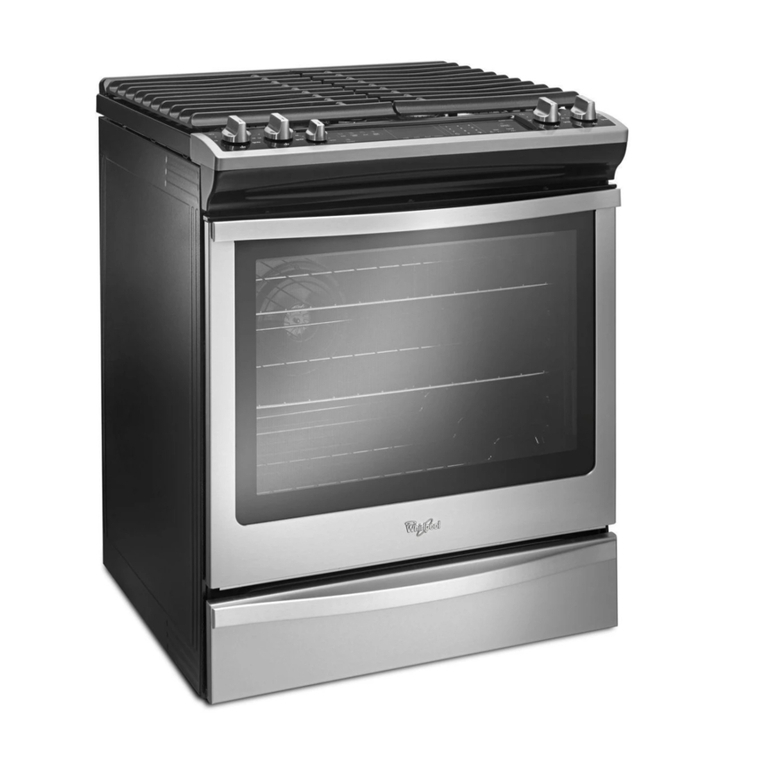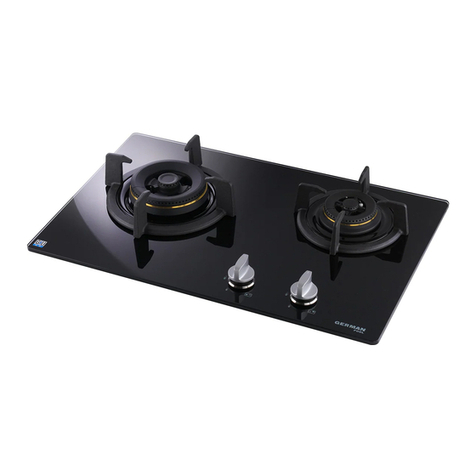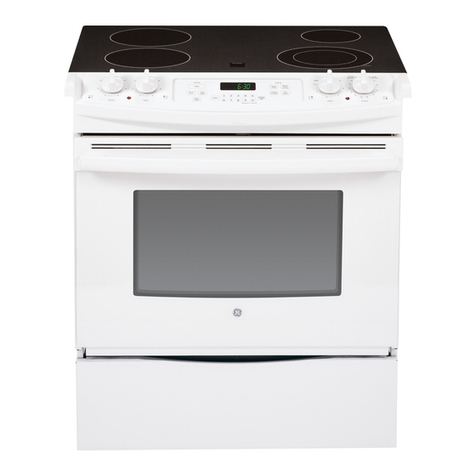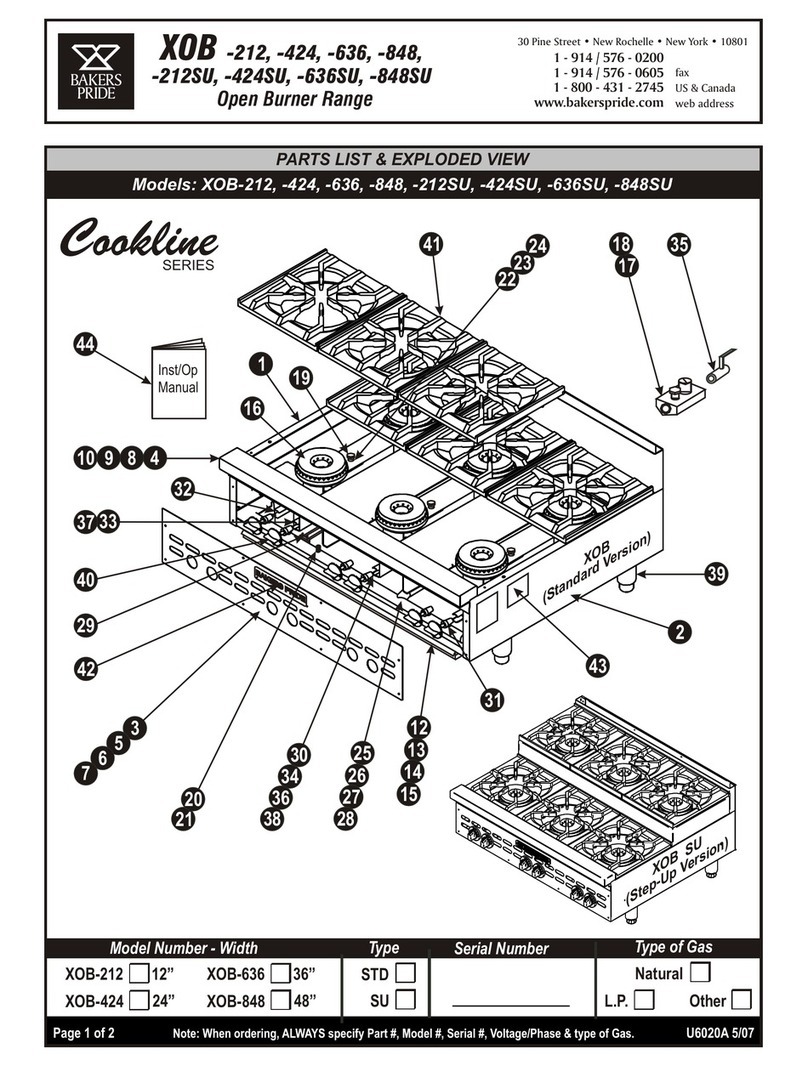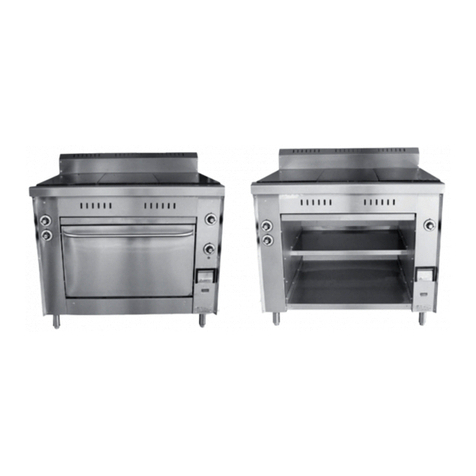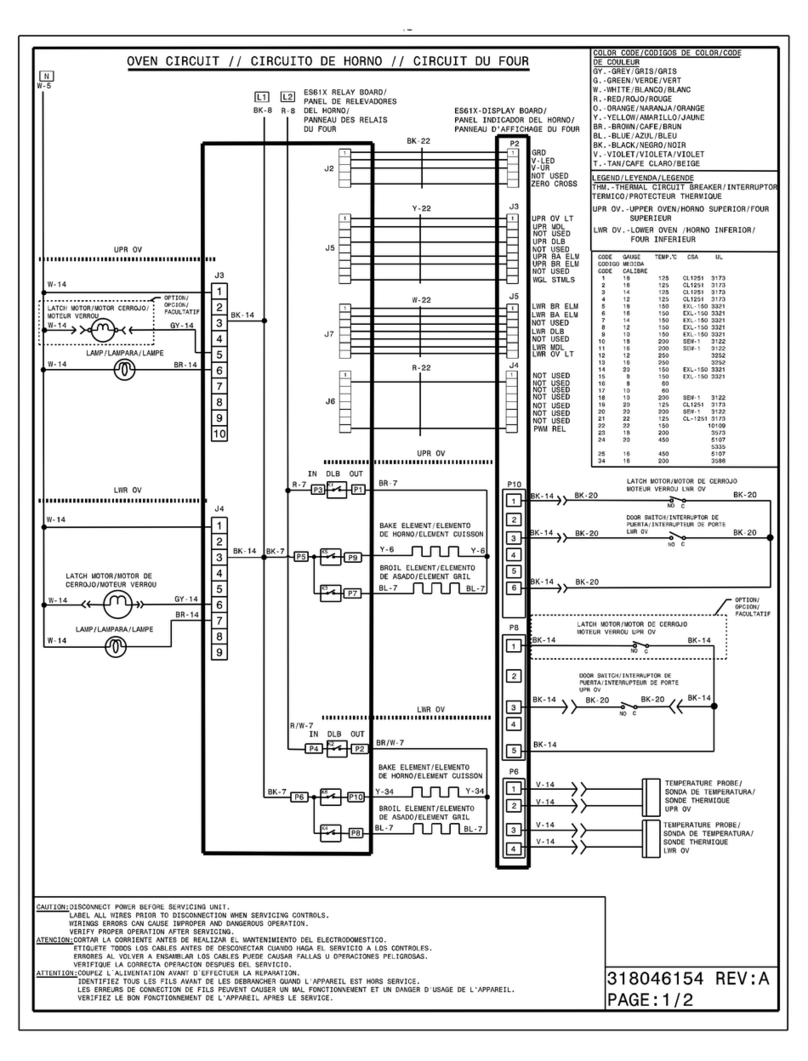Roper FEP350Y User manual

UseAndCare
A Note To You
ImportantSafety
lnsttuctions 3
Parts And Features 6
Using Your Range 7
Carin For
Your angeI! 19
If You Need
tizL%z 26
Warranty 28
1-800-&ROPER
Cd
USwith
questions or mments.
STANDARD-CLEANING ELECTRIC RANGE a-s3
MODEL FEP350Y

ANoteToYou
Thank you for buying a Roper appliance.
You have purchased a quality, worldclass home appliance. Years of engineering experience have gone
into its manufacturing. To ensure that you will enjoy many years of trouble-free operation, we have
developed this Use and Care Guide. It is full of valuable information on how to operate and maintain
your appliance properly and safely. Please read it carefully. Also, please complete and mail the Owner-
ship Registration Card provided with your appliance. This will help us notify you about any new informa-
tion on your appliance.
Your safety is important to us.
This guide contains safety symbols and statements. Please pay special attention to these symbols and
follow any instructions given. Here is a brief explanation of the use of each symbol.
This symbol will help alert you to such dangers as
personal injury, burns, fire and electrical shock. This symbol will help you avoid actions which
could cause product damage (scratches, dents,
etc.) and damage to your personal property.
Our toll-free number, I-80044-ROPER (l-800447-67371, is
available 24 hours a day.
If you ever have a question concerning your appliance’s operation, or if you need service, first see “If
You Need Assistance Or Service” on page 26. If you need further help, feel free to call us. When calling,
you will need to know your appliance’s complete model number and serial number. You can find this
information on the model and serial number plate (see diagram on page 6). For your convenience, we
have included a handy place below for you to record these numbers, the purchase date from the sales
slip and your dealer’s name and telephone number. Keep this book and the sales slip together in a safe
place for future reference.
Model Number
Serial Number
Purchase Date
Dealer Name
Dealer Phone
2

ImportantSafetylnstructions
General
To reduce the risk of fire, electrical shock, injury to
persons, or damage when using the range, follow
basic precautions, including the following:
l
Read all instructions before
using the range.
*Install or locate the range onl
J in
accordance with the provide
Installation Instructions. The
ran9e must be installed by a
qua ified installer. The range .DO NOT TOUCH SURFACE
must must be properly con- UNITS, AREAS NEAR UNITS,
netted to electrical supply and HEATING ELEMENTS OR
grounded. INTERIOR SURFACES OF
@o @
OVEN. Surface units and heat-
ing elements may be hot even
though they are dark in color.
Areas near surface units and
interior surfaces of an oven
l
WARNING: To reduce the risk of become hot enou h to cause
tipping of the ap
appliance must 1 liance, the burns. During ancp
after use,
e secured by a do not touch, or let clothing or
groperly installed anti-tip other flammable materials
racket. To check if the bracket contact surface units, areas
is installed properly, see “The near units, heatin 7 elements or
anti-tip bracket” on page 18. interior surfaces 0 oven until
@CAUTION: Do not store things they have had sufficient time
children mi ht want above the to cool. Other surfaces of the
range. Chil %ren could be burned range may become hot enough
or injured while climbing on it. to cause burns; such as, the
l
Do not leave children alone or oven vent opening, the surface
unattended in area where the near the the
range is in use. They should cooktop, r and
never be allowed to sit or stand window.
on an
could Ii part of the range. They
e burned or injured.
l
Do not operate the range if
it is damaged or not working
properly. @Donot wear loose or hanging
@Donot use the range for garments when using the
warming or heatin ii!the room. range. They could ignite if they
Persons could be urned or touch a hot surface unit and
injured, or a fire could start. you could be burned.
continued on next page
3

‘Use only dry otholders. Moist or
damp pothol 8ers on hot surfaces
may result in bums from steam.
Do not let potholder touch hot
heating elements. Do not use a
towel or bulky cloth for a
potholder. It could catch on fire.
Keep range vents unobstructed.
‘Do not heat unopened contain-
ers. They could explode. The hot
contents could cause burns and
container particles could cause
Injury.
Do not store flammable materials
on or near the ran e. The fumes
can create an exp osion and/or
?
fire hazard.
Mhen usina the cooktou
Make sure the reflector bowls
are in place during cooking.
Cookin %without reflector bowls
may su ject the wirin
ponents underneath t
a and com-
em to
damage.
Do not line reflector bowls with
aluminum foil or other liners.
Improper installation of these
liners ma result in a risk of
electric stY
ock or fire.
Select a pan with a flat bottom
that is about the same size as
the surface unit. If pan is smaller
than the surface unit, some of
the heating element will be
exposed and may result in the
i
8 niting of clothing or potholders.
orrect pan size also improves
cooking efficiency.
l
Check to be sure glass cooking
utensils are safe for use on the
range. Only certain types of
glass, glass-ceramic, ceramic,
earthenware or other glazed
utensils are suitable for
cooktops without breaking due
to the sudden change in
temperature.
ONever leave surface units
unattended at high heat set-
tings. A boilover could result
and cause smoking and greasy
spillovers that may ignite.
@Turnpan handles inward, but
not over other surface units.
This will help reduce the
chance of burns, i niting of
flammable materia s,9 and spills
due to bumping of the pan.
When using the oven
l
Always osition oven rack(s) in
desired ocation while oven IS
P
cool. If a rack must be removed
while oven is hot, do not let
potholder contact hot heating
element in oven.
.Use care when opening oven
door. Let hot air or steam
escape before removing or
replacing food.
4

Grease Care and cleaning
@Grease is flammable. Do not *Do not soak removable heating
allow grease to collect around elements in water. The element
cooktop or in vents. Wipe spill- will be damaged and shock or
overs immediately. fire could result.
.Do not clean door heat seal. It
*
is essential for a good seal.
Care should be taken not to
rub, damage or move the seal.
Clean only parts recommended
in this Use and Care Guide.
.Do not repair or replace any
ADOnot use water on grease part of the range unless specifi-
fires. Never pick up a flaming tally recommended in this
pan. Smother flamin pan on
9 manual. All other servicing
range by coverin WIh a well-
% should be referred to a quali-
fitted lid, cookie s eet or flat fied technician.
tray. Flaming grease outside of
l
Disconnect the electrical supply
E
an can be extin uished with
9 before servicing the range.
aking soda or, i available, a
multipurpose dry chemical or
foam-type extinguisher.
- SAVE THESE INSTRUCTIONS -

PartsAnd Features
This section contains captioned illustrations of your range. Use them to become familiar with the
location and appearance of all parts and features.
Anti-tip bracket
(on wall behind backguard)
Plugin
surface unit Automatic oven
reflector bowl Broil element
Removable Bake element
Control panel
Left front Lafi rear Manual oven Oven temperature Oven
control knob control knob light switch control knob selector
I I I I
I I
Surface unit Surface heating
marker indicator light Automatic MEALTIMER” Oven heating
clock/Minute Timer Right rear Right front
indicator light control knob control knob
6

Using Your Range
In This Section Paw
Using the surface units ..................................... .7
Positioning racks and pans ............................... 9
For best air circulation ..................................... 10
Using aiuminum foil for baking ....................... 10
Betting the decbonk clock.. ........................... 11
Using the eiectronk Timer .............................. 11
Bakinglroasting ................................................ 12
Adjusting the oven temperature control ....... .12
Page
Broiling .............................................................. 13
Broiling tips ....................................................... 14
Energy saving tips ............................................ 14
Using the automatic MEALTIMER” clock ....... 15
The oven vent ................................................... 17
The storags drawer .......................................... 17
The an&tip bracket .......................................... 19
To obtain the best cooking results possible, you must operate your range properfy. This section gives
you important information for efficient and safe use of your range.
Using the surface units
Push in control knobs before turning them to a
setting. You can set them anywhere between HI
and OFF.
Surface unit markers
The solid dot in the surface unit marker shows
which surface unit is turned on by that knob.
Surface heating indicator light
The SURFACE HEATING Indicator Light on the
control panel will glow when a surface unit is
turned on.
Burn and Fire Hazard
Be sure all control knobs are turned to OFF
and all indicator lights are OFF when you
are not cooking.
Someone could be burned or a fire could
start if a surface unit is accidentally left ON.
7

Until you get used to the settings, use the
following as a guide For best results, start
cooking at the high setting: then turn the control
knob down to continue cooking.
1 SETTING 1 RECOMMENDED USE I
HI
MED-HI
MED
l
To start foods cooking.
l
To bring liquids to a boil.
l
To hold a rapid boil.
l
To fry chicken or pancakes.
l
For gravy, pudding and icing.
l
To cook large amounts of
vegetables.
I
MEDLO -
l
To keep food cooking after
starting it on a higher setting.
I
LO
l
To keep food warm until ready
to serve.
Cookware tips
l
Select a pan that is about the same size as the
surface unit.
l
NOTE: For best results and greater energy
efficiency, use only flat-bottomed utensils that
make good contact with the surface units.
Utensils with rounded, warped, ridged (porce-
lain enamel-ware) or dented bottoms could
cause severe overheating, which damages the
utensil and/or surface unit.
Woks, canners and teakettles with flat
bottoms suitable for use on your cooktop are
now available in most stores that sell
housewares.
l
The pan should have straight sides and a tight-
fitting lid.
l
Choose medium to heavy gauge (thickness)
pans that are fairly light-weight.
l
The pan material (metal or glass) affects how
fast heat transfers from the surface unit through
the pan material and how evenly heat spreads
over the pan bottom. Choose pans that provide
the best cooking results.
l
Handles should be made of sturdy, heat-
resistant material and be securely attached to
the pan.
Product Damage Hazard
l
If a surface unit stays red for a long time,
the bottom of the pan is not flat enough or
is too small for the surface unit. Prolonged
usage of incorrect utensils for long periods
of time can result in damage to the surface
unit, cooktop, wiring and surrounding areas.
To prevent damage, use correct utensils,
start cooking on HI and turn control down
to continue cooking.
l
Do not leave an empty utensil, or one which
has boiled dry, on a hot surface unit. The
utensil can overheat and may damage the
utensil or surface unit.

Home canning information
To protect your range:
. Use flat-bottomed canners/pans for best
results.
l
Use the largest surface unit for best results.
Also, use a canner/pan which can be centered
over the surface unit and which does not
extend more than one inch outside surface unit
area. Large diameter canners/pans, if not
properly centered, trap heat and can cause
damage to the cooktop.
l
Do not place canner on two surface units at
the same time. Too much heat will build up and
will damage the cooktop.
l
Start with hot water. This reduces the time the
control is set on high. Reduce heat setting to
lowest position needed to keep water boiling.
l
Keep reflector bowls clean for best heat
reflection.
l
To prolong the life of the elements:
- Prepare small batches at a time.
- Do not use elements for canning all day.
Optional canning kit
The large diameter of most water-bath or
pressure canners combined with high heat
settings for long periods of time can shorten the
life of regular surface units and cause damage to
the cooktop.
If you plan to use the cooktop for canning, we
recommend the installation of a Canning Kit.
Order the kii (Part No. 242905) from your Roper
dealer or authorized Roper service company.
Positioning racks and pans
For baking/roasting with one rack, place the
rack so the top of the food will be centered in the
oven.
Rack placement for specific foods: Personal Injury Hazard
l
Always position oven rack(s) in desired
location before turning oven on. Be sure
l
if rack(s) must be moved while oven is
hot. use potholders or oven mitts to
When baking on two racks, arrange racks on
bottom and third level from bottom.
NOTE: For recommended rack placement when
broiling, see “Broiling rack position chart” on
page 14.
9

For best air circulation
The hot air must circulate around the pans in the
oven for even heat to reach ail parts of the oven.
This results in better bakfng.
l
Place the pans so that one is not directly over
the other.
l
For best results, allow 1’55to 2 inches (4-5 cm)
of space around each pan and between pans
and oven wails. There must be a minimum
space of 1 inch (2.5 cm).
l
Use only one cookie sheet in the oven at one
time.
Use the following as a guide to determine where
to place the pans.
One pan
Place in the center of the oven rack.
Two pans
Place in opposite corners of the oven rack
Three or four pans
Place in opposite corners on each oven rack.
Stagger pans so no pan is directly over another.
Using aluminum foil for baking
Use aluminum foil to catch spillovers from pies or
casseroles.
l
Place the foil on the oven rack below the rack
with the food. Turn up foil edges and make sure
foil is about 1 inch (2.5 cm) larger all around
than the dish holding the food.
l
Do not cover the en&e rack with aluminum foil.
it will reduce air circulation and cause poor
cooking results.
l
Do not line oven bottom with foil or other liners.
Poor baking will result.
Electrical Shock and Fire Hazard
Do not allow foil to touch the heating
elements because it will damage them and
could result in shock or fire hazard.
10

Setting the electronic clock
When you first plug in the range, or if your
electricity was off for a while, all indicators will
come on and the display will show “88:88”. The
display will then change to “--:--“. SET and the
Clock Indicator will show in the display.
1. Push the Clock button. ‘12:OO” will show in
the display.
Using the electronic Timer
The Timer does not start or stop the oven. it
works like a kiichen timer. Set it in minutes up to
24 hours.
1.
2.
Push the Timer button. SET, TIMER, HR and
MN will come on and the display will show “:OO”.
Turn the Set Knob until the desired time
shows in the display. The timer will begin
counting down two seconds after the time is
set. You will hear two tones when one minute
is remaining on the timer. When the time is up,
you will hear three tones. After the three
tones, the display will return to the time of day
and TIMER will flash. You will hear two tones
every 10 seconds until you cancel the Timer.
3. To cancel Timer after countdown is over,
push the Clock button and the display will return
to the time of day. TIMER will stop showing.
To cancel Timer before
countdown is over:
Push the Timer button. The display will show
SET, TIMER. HR. MN and “:OO”for a few
seconds. The time of day will then be displayed.

Baking/roasting
1. Position the rack(s) properly before turning
on the oven. To change rack Position, lift
rack at front and pull out. For further informa-
tion, see “Positioning racks and pans” on
page 9.
2. Set the Oven Selector to BAKE.
3. Set the Oven Temperature Control Knob to
the baking/roasting temperature you want. The
OVEN HEATING Indicator Light will come on.
The oven is preheated when the OVEN
HEATING Indicator Light first goes off.
NOTE: Do not preheat oven when roasting or
cooking items such as casseroles.
4. Put food in the oven.
During baking/roasting, the elements will
turn on and off to maintain the temperature
setting. The OVEN HEATING Indicator Light
will turn on and off with the elements.
NOTE: The top element helps heat during
baking/roasting, but does not turn red.
5. When baking/roasting is done, turn both
the Oven Selector and the Oven Temperature
Control Knob to OFF. The OVEN HEATING
Indicator Light will go off.
Adjusting the oven temperature control
Oven temperature controls will gradually shift
after years of use. So, even though your new
oven is properly adjusted to provide accurate
temperatures, it may cook faster or slower than
your old oven.
If, after using the oven for a period of time, you
are not satisfied with the temperature settings,
you can change them by following these steps:
1. Turn the Oven Temperature Control Knob to
the off position. Pull knob straight off and flip
it over.
12

2. Loosen the locking screws inside the control
knob. Note the position of the notches.
3. To lower the temperature, hold knob handle
firmly and move the tooth a notch counter-
clockwise. Each notch equals about 10°F
(5°C).
4. To raise the temperature, hold knob handle
firmly and move the tooth a notch clockwise.
Each notch equals about 10°F (5%).
Tighten the locking screws and replace the
control knob.
Broiling
1. Position the rack properly before turning on
the oven. Position rack so that the surface of
the food is at least 3 inches (7.4 cm) away
from the broil element. SW “Broiling rack
position chat-t” on page 14.
2. Put the broiler pan and food on the rack
3. Close the door to the Broil Stop position (open
about 4 inches [lo.2 cm]). The door will stay
open by itself.
4. Set the Oven Selector and Oven Temperature
Control Knob to BROIL. The OVEN HEATING
Indicator Light will come on.
NOTE: Do not preheat oven when broiling.
5. When broiling is done, turn both the Oven
Selector and Oven Temperature Control Knob
to OFF. The OVEN HEATING Indicator Light
will go off.
Custom broil
l
If food is cooking too fast, turn the Oven
Temperature Control Knob counterclockwise
until the OVEN HEATING Indicator Light
goes off.
l
If you want the food to broil slower from the
start. set the Oven Temperature Control Knob
between 170°F and 325’F (77°C and 163%).
These temperature settings allow the broil
heating element to cycle and to slow cooking.
The lower the temperature, the slower the
cooking.
l
Fish and chicken are some foods that may cook
better if you use lower broiling temperatures.
The Oven Selector must be on BROIL for all
broiling temperatures.
NOTE: Leave the oven door partly open when-
ever using the oven to broil. This allows the oven
to maintain proper temperatures.
13

Broiling rack position chart
2
TYPE OF FOOD/
DONENESS
Hamburger patties and thin
steaks, %” thick or less
Quickly searing food, rare
and medium steaks,
medium patties, ham slices,
fish steaks. franldurters
Welldone steaks and
patties, lamb chops, split
chicken, pork steaks and
chops, whole fish
Broiling tips
. Use the broiler pan and grid for broiling. They
are designed to drain excess liquid and fat
away from the cooking surface to help prevent
spatter, smoke or fire.
l
Refer to a broiling chart in a reliable cookbook
for correct broiling times.
l
After broiling, remove the broiler pan from the
oven when you remove the food. Drippings will
bake on the pan if you leave it in the heated
oven.
Fire Hazard
l
Place meat the correct distance from the
element. Meat placed too close to the
element may spatter, smoke, burn or catch
fire during broiling.
l
To ensure adequate grease drainage, do
not use cookie sheets or similar pans for
broiling. Also, covering the broiler grid with
foil is not recommended. Poor drainage of
grease may result in fire. If foil is used, cut
slits in foil to line up with all openings in
broiler grid. Grease can then drain away and
cool in pan.
Energy saving tips
Although the energy used for cooking is usually a
very small percentage of the total energy used in
the home, cooking energy can be used efficiently.
Here are some tips to help you save energy
when using your cooking product.
l
Use pans with flat bottoms, straight sides and
tight-fitting lids.
l
Match the pan to the surface unit size.
l
Cook with a minimum of liquid or fat to help
shorten cooking time.
l
Preheat pans only when recommended and for
the shortest time possible.
l
Start food on higher heat settings, then set
surface unit control on low or off to finish
cooking. Use retained heat for cooking when
possible.
l
Use the more efficient surface unks instead of
the oven when possible.
14
l
Turn on the surface unit only after placing filled
pan on the unit.
l
“Oven peeking” may cause heat loss, longer
cooking times and unsatisfactory baking
results. Rely on your timer to keep track of the
cooking time.
l
Bake cakes, pies or cookies when oven is
warm. Best time is after a meal has been
cooked in it.
l
Preheat the oven no longer than necessary.
l
Plan your meals for the most efficient use of
the range. When using the oven to cook one
food, try to cook the rest of the meal in it also.
l
Do not preheat when broiling, roasting or
cooking items such as casseroles.
l
Keep reflector bowls clean for best heat
reflection.

Using the automatic MEALTIMER” clock
The automatic MEALTIMER clock is designed to
turn the oven on and off at times you set ... even
when you are not around.
Delayed time bakingroasting is ideal for foods
which do not require a preheated oven, such as
meats and casseroles. Do not use the delayed
time cycle for cakes, cookies, etc. ...
undercooking will result.
Before using the MEALTlMER clock, make
sure the clock is set to the correct time of day.
(See “Setting the electronic clock? on page 11.)
To delay start and stop
automatically:
1.
2.
3.
4.
5.
6.
Posltlon the oven rack(s) properly and place
the food in the oven.
Push the Cook Time button. Then turn the
Set Knob to set the cooking time you want
(up to 11 hours, 50 minutes).
After five seconds, only COOK and the
cooking time will show in the display.
Push the Start Time button. Then turn the
Set Knob to set the start time you want (up to
11 hours, 59 minutes from the current time of
day). In example shown, a two-hour cooking
time and a 4 o’clock start time would cause the
oven to turn off at 6 o’clock.
After five seconds, only DELAY and the
time of day will show in the display.
Set the Oven Selector to TIME BAKE.
Set the Oven Temperature Control Knob to
the bakingroasting temperature you want. The
oven will now start and stop automatically. The
OVEN HEATING and ON Indicator Lights will
come on when the start time is reached. Only
COOK and the cooking time will show in the
display.
After baking/roasting is done, you will hear
three tones, the display will return to the time
of day, and COOK will flash. You will hear two
tones every 10 seconds until you cancel the
MEALTIMER clock. To cancel, push any
button and COOK will stop showing. Turn both
the Oven Selector and Oven Temperature
Control Knob to OFF.
NOTE: If the Timer is on, the display will return
to the countdown. COOK will flash and TIMER
will come on. Push any button to make COOK
stop showing.
To cancel the setting after oven has started:
Push the Cook Time button twice.
To cancel the setting before oven has started:
Push the Cook Time button twice. Then push the
Start Time button twice. 15

To start baking/roasting now
and stop automatically:
1. Position the oven rack(s) properly and place
the food in the oven.
2. Push the Cook Time button. Then turn the
Set Knob to set the cooking time you want (up
to 11 hours, 50 minutes).
After five seconds, only COOK and the
cooking time will show in the display.
3. Set the Oven Selector to TIME BAKE.
4. Set the Oven Temperature Control Knob to
the baking/roasting temperature you want.
5. After baking/roasting is done, you will hear
three tones, the display will return to the time
of day, and COOK will flash. You will hear two
tones every 10 seconds until you cancel the
MEALTIMERTM clock. To cancel, push any
button and COOK will stop showing. Turn
both the Oven Selector and Oven Tempera-
ture Control Knob to OFF.
NOTE: If the Timer is on, the display will
return to the countdown. COOK will flash and
TIMER will come on. Push any button to make
COOK stop showing.
To cancel the setting after oven has started:
Push the Cook Time button twice.
To avoid sickness and food waste when
using the MEALTIMER” clock:
l
Do not let most UNFROZEN food stand
for more than two hours before cooking
starts.
l
Do not allow food to remain in oven for
more than two hours after the end of
cooking cycle.
NOTE: Do not use foods that will spoil while
waiting for cooking to start. Such foods are:
dishes with milk or eggs, cream soups, and
cooked meats or fish. Also, foods containing
baking powder or yeast will not rise properly
when cooked using delay start.
16

The oven vent
Hot air and moisture escape from the oven
through a vent under the right rear surface unit.
You can cook on the unit or keep food warm on it
while the oven is on. The vent is needed for air
circulation. Do not block the vent. Poor baking/
roasting can result.
NOTE: Plastic utensils left over the vent can melt.
Burn and Fire Hazard
If you leave a utensil on the right rear
surface unit, use potholders when moving
it. Pan handles can become hot enough to
burn.
Keep flammable materials away from oven
vent.
Failure to do so can result in burns or a fire.
The storage drawer
You can remove the storage drawer to make it
easier to clean under the range. Use care when
handling the drawer.
Removing the storage drawer:
1. Empty drawer of any pots and pans before
removing drawer. Pull drawer straight out to
the first stop. Lii front and pull out to the
second stop.
2. Lii back slightly and slide drawer all the
way out.
Replacing the storage drawer:
1. Fit ends of drawer slide rails into the drawer
guides on both sides of opening.
2. Lift drawer front and push In until metal stops
on drawer slide rails clear white stops on
drawer guides. Lii drawer front again to clear
second stop and slide drawer closed.
Drawer’rlida rail lv
17

The anti-tip bracket
The range will not tip during normal use. How-
ever, tipping can occur if you apply too much
force or weight to the open door without the anti-
tip bracket properly secured.
To verify the anti-tip bracket Is engaged:
l
Look to see if the anti-tip bracket is attached
with screws to the wall behind the backguard.
l
Make sure the cable tether on the back of the
range is secured by the two hooks on the
bracket.
l
See Installation Instructions for further details.
18

Caring For Your Range
r-
In This Section
Paw
Page
Surface units and reflector bowlr
...................19
Lift-up cooktop ................................................. 22
Removing the oven door ................................. 22
Cleaning chart.. ................................................ .23
The oven light .................................................. .25
Your range is designed for ease of care. You can
do most cleaning with items found around your
home. Cleaning your range whenever spills or
soiling occurs will help to keep it looking and
Burn
and Electrical Shock Hazard
operating like new. ’ ’ Make sure all controls are OFF and the
range is cool before cleaning.
Failure to do so can result in burns or
electrical shock
Surface units and reflector bowls
Removing
1. Make sure all surface units are off and cool
before removing surface units and reflector
bowls.
2. Lift the edge of the unit, opposite the recep-
tacle, just enough to clear the element hold-
down clip and the reflector bowl.
19

3. Pull the surface unit straight away from the
receptacle.
4. Lift out the reflector bowl. See “Cleaning
chart-” on page 23 for cleaning instructions.
Replacing
1. Make sure all surface units are off and cool
before replacing surface units and reflector
bowls.
2. Line up openings in the reflector bowl with the
surface unit receptacle and the element hold-
down clip.
20
Table of contents
Other Roper Range manuals
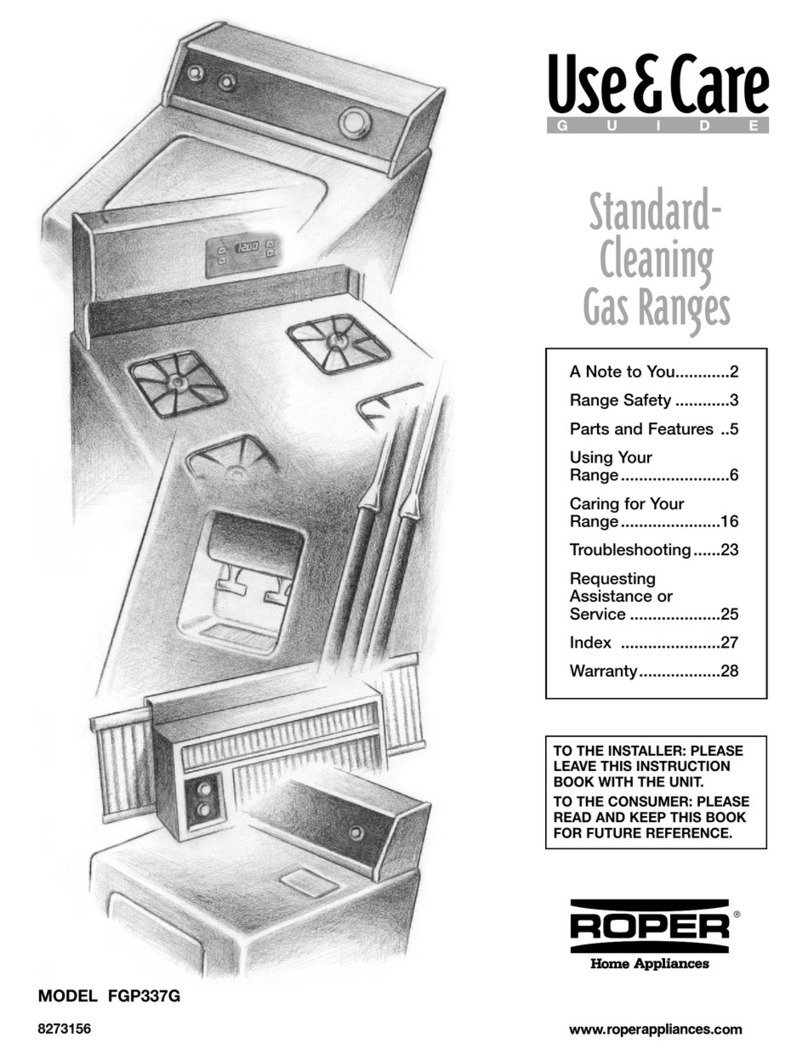
Roper
Roper FGP337G User manual

Roper
Roper FGP314TQ0 User manual
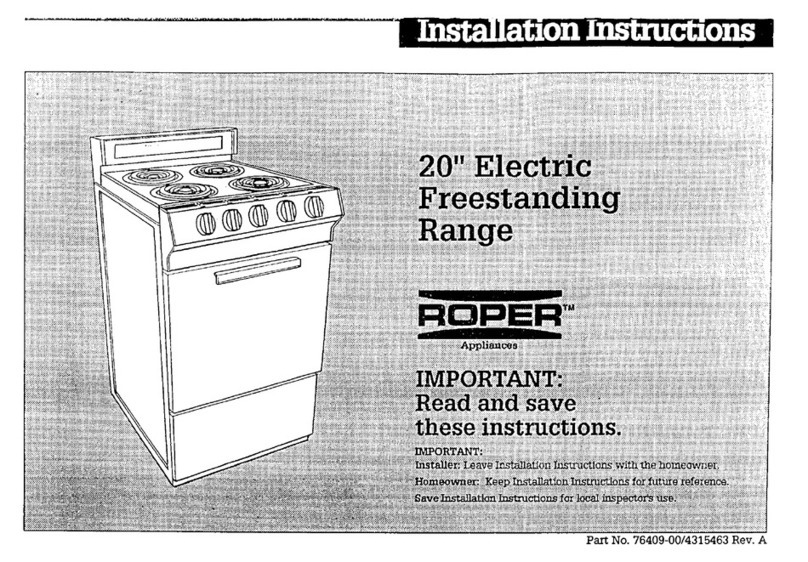
Roper
Roper Roper FEP210VL0 User manual
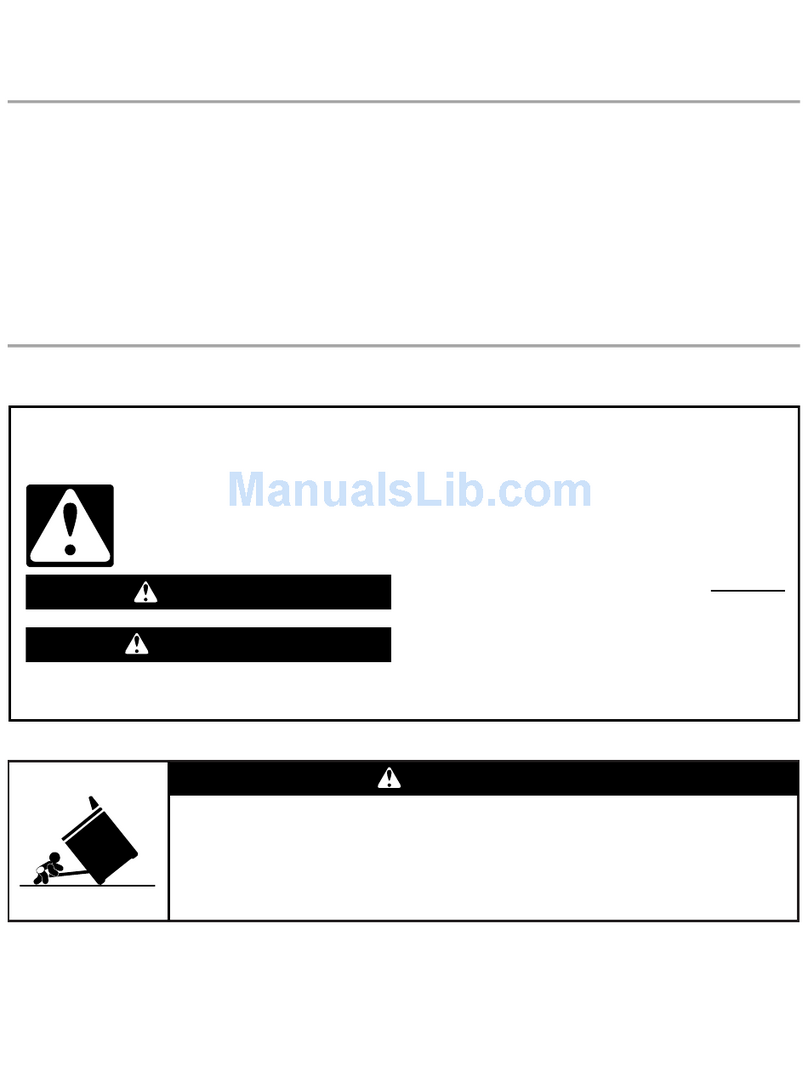
Roper
Roper FGS326RD User manual
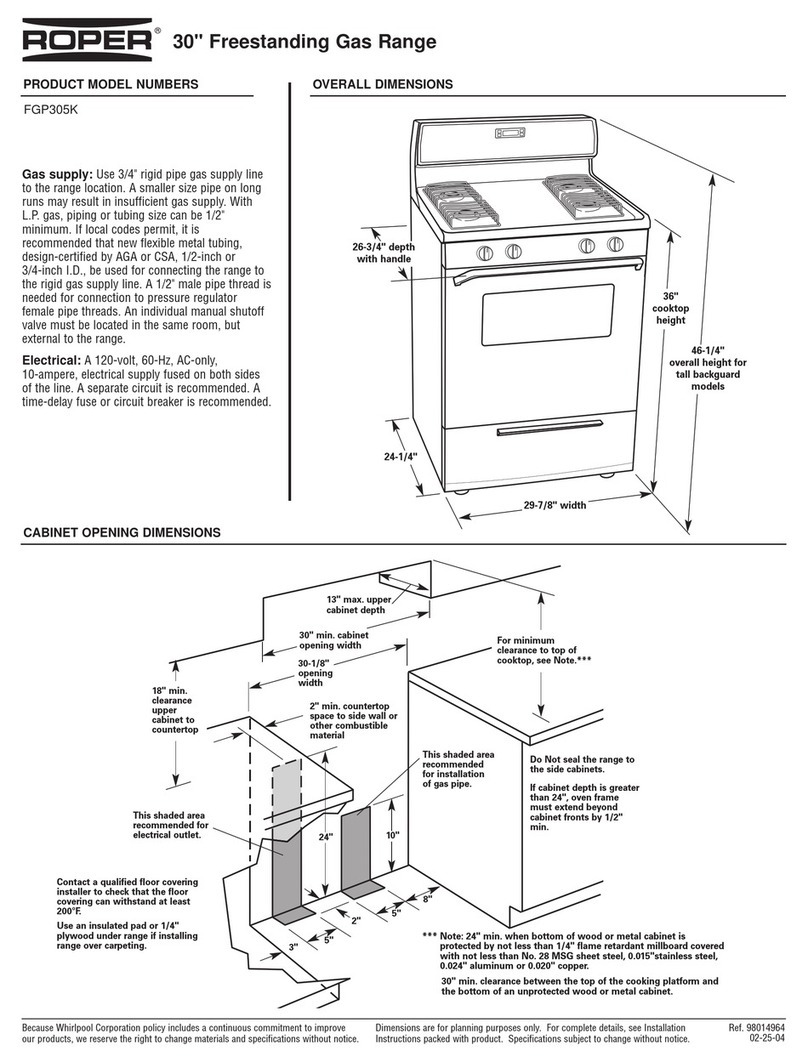
Roper
Roper FGP305KW User guide
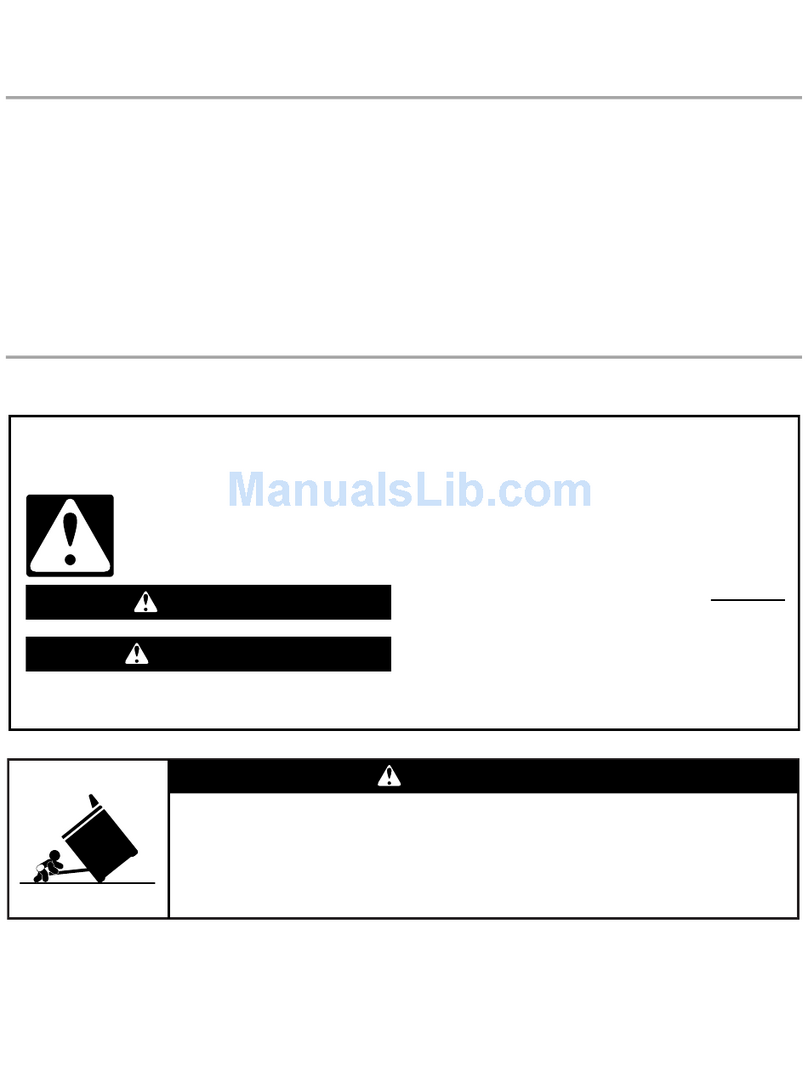
Roper
Roper FEP310KW User manual
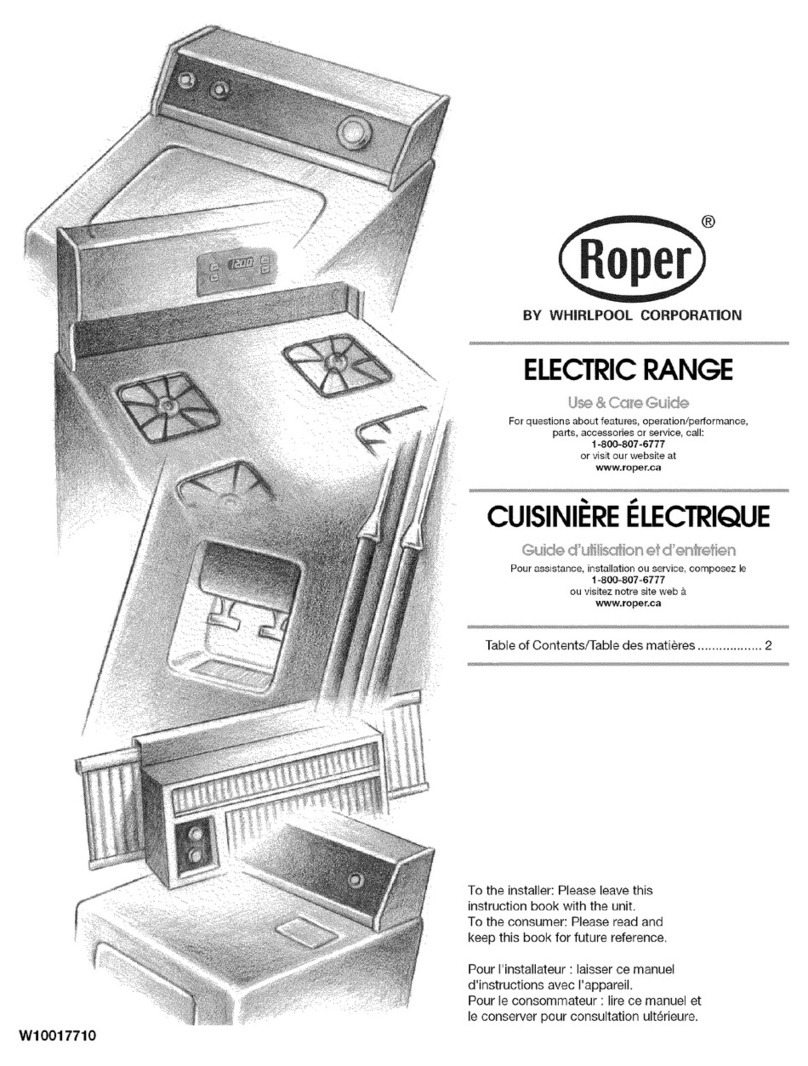
Roper
Roper RME30003 User manual
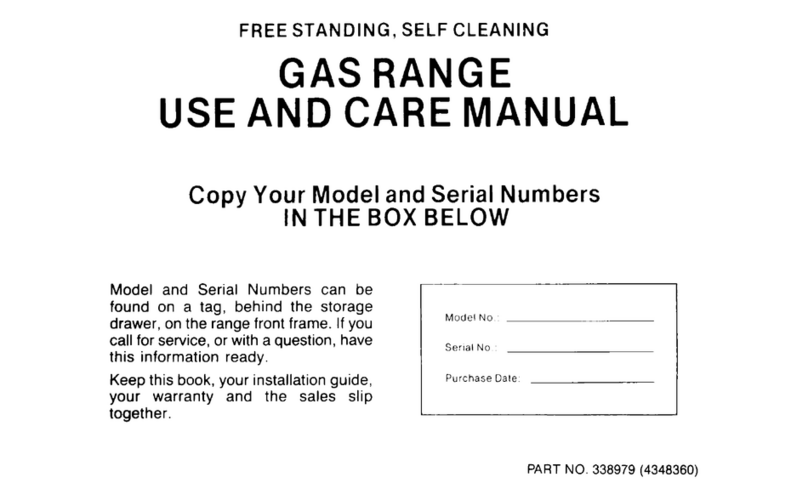
Roper
Roper F8858W0 User manual

Roper
Roper W10017530 User manual

Roper
Roper SGS395X User manual
Popular Range manuals by other brands
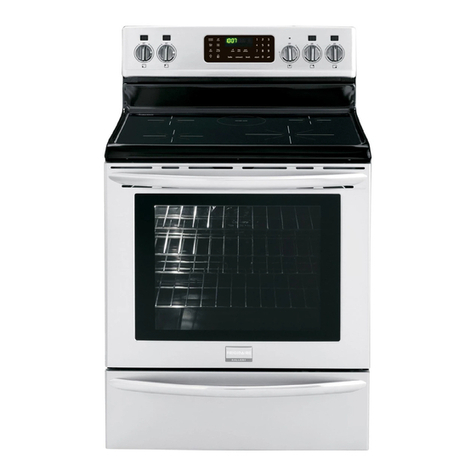
Frigidaire
Frigidaire Gallery FGIF3061NFF Use & care guide
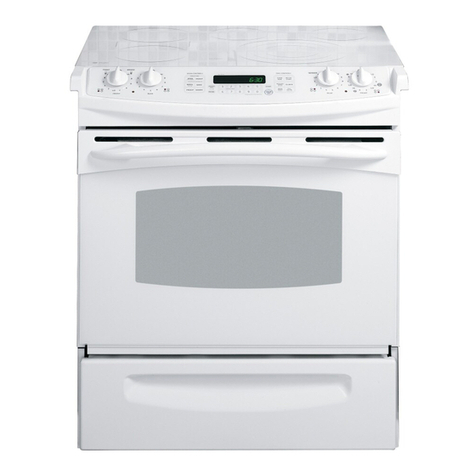
GE
GE PS968SPSS use and care manual
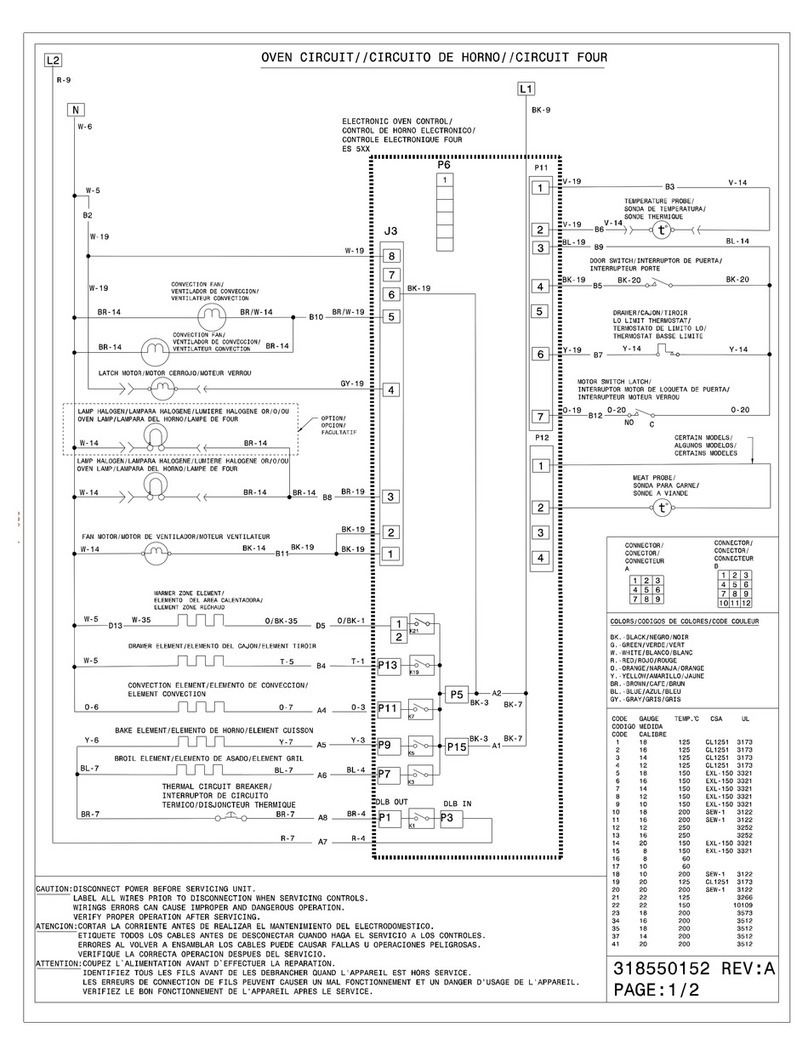
Frigidaire
Frigidaire FPES3085KF - 30" Slide-In Smoothtop Electric... Wiring diagram
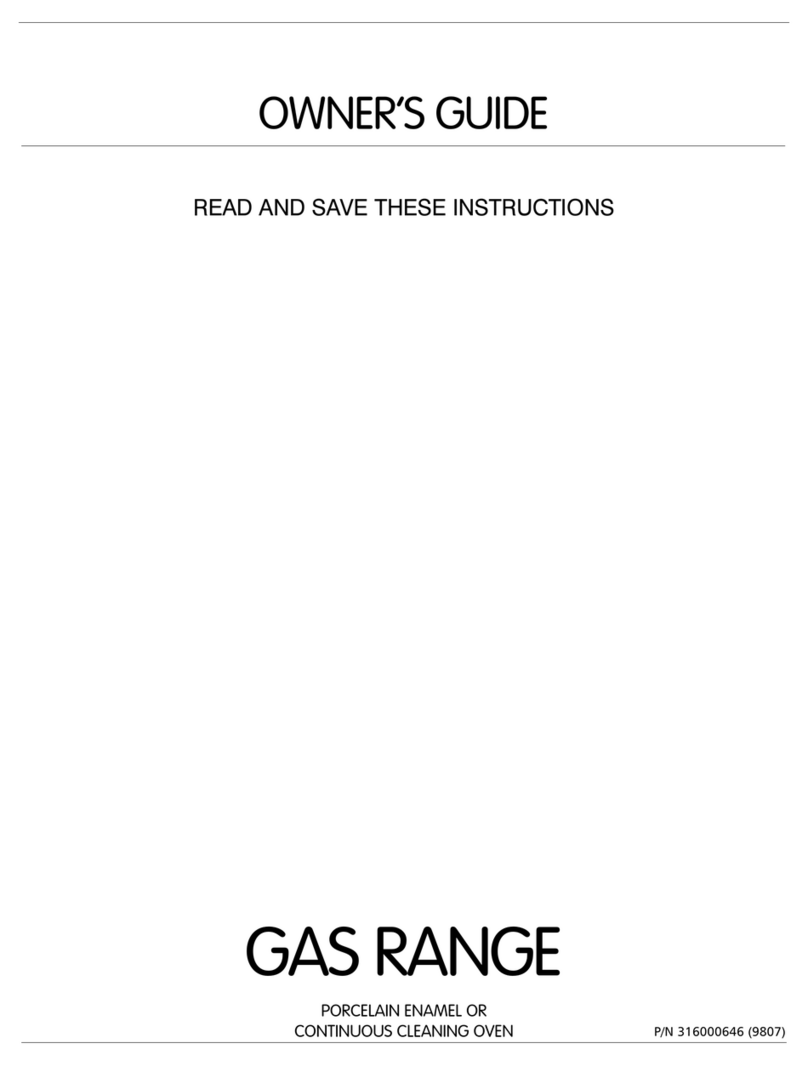
Frigidaire
Frigidaire FGF316WGTE owner's guide
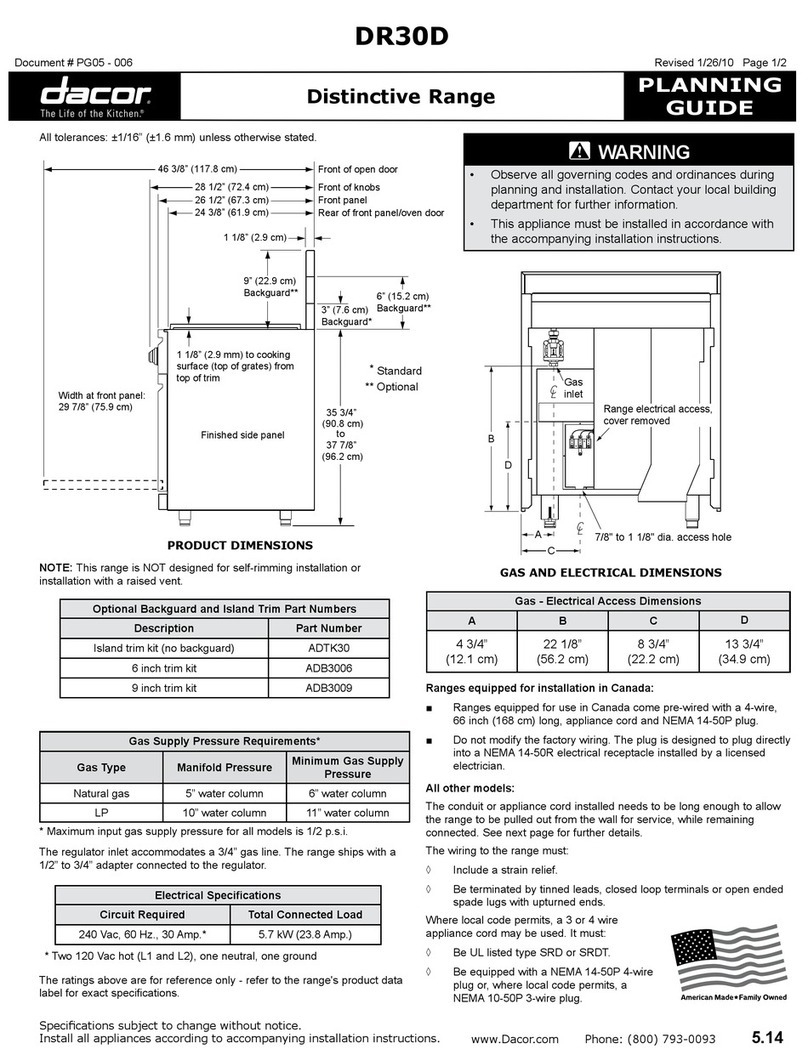
Dacor
Dacor Millenia DR30D Planning guide
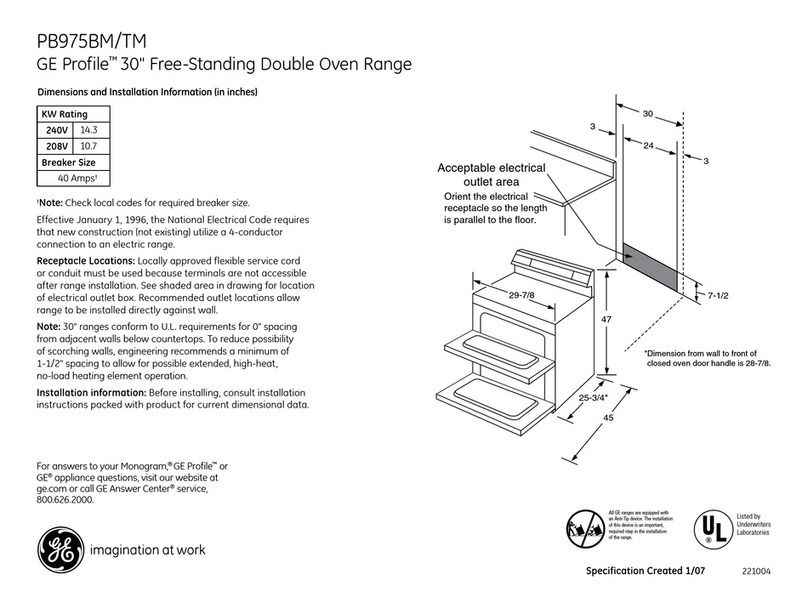
GE
GE Profile PB975TMWW Dimensions and installation information
